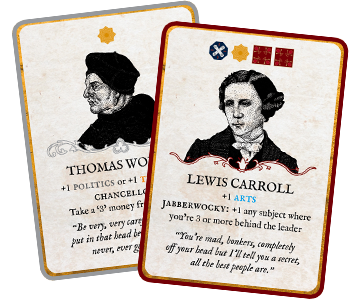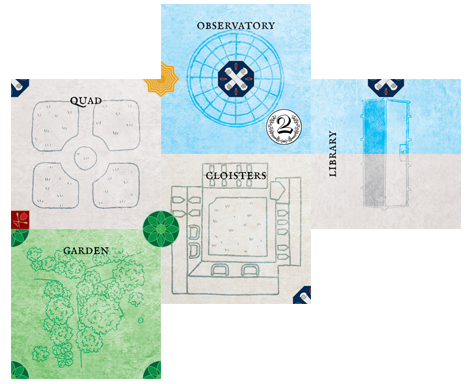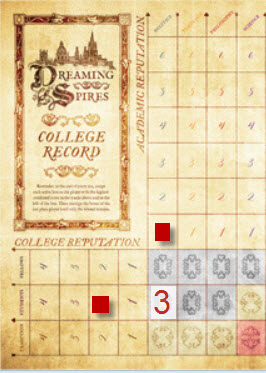You’ve probably heard that old saying that learning is fun, and for some out there, this is true. There are those who enjoyed schooling as they sought to unravel the mysteries of how the universe worked, tackling anything and everything that caught their fancy.
For others, a scholastic education at some point becomes a chore, a necessary evil to muddle through before they could get on with whatever truly held their attention. Sure, these people may have learned enough to get by, but their tenure in school was at times tedious, boring, or entirely unpleasant.
Well…we’re going to focus on that first group. So, welcome to Oxford.
Dreaming Spires takes place within the hallowed halls of the University of Oxford and across the span of its centuries-long history. Taking place over eight rounds, the game spends two rounds progressing through each of the Medieval, Renaissance, Imperial, and Modern ages of the institution. During each era, players take turns trying to create the most idyllic college by raising new buildings, recruiting famous attendees from the school’s past, and dealing with a pair of events that affected the region in each age.
The goal is to present the most well-rounded and appealing version of Oxford that you can, and it’s more fun than it sounds. Honest.
Ultimately, two things stand out with Dreaming Spires. Firstly is the theme itself. Without the veneer of the prestigious locale, Dreaming Spires is essentially a tile building game like Carcassonne, where players go about crafting their version of the Oxford campus. But it takes that simple idea and adds to it in a thematic way.
At the start of each age, a series of scholars are revealed. Scholars like these:

Prototype Shown
Each round consists of an Event card also being revealed and then each players taking four actions. One of the two things you’ll do frequently is adding new building tiles to your school, both to increase the completion of various tile symbols – called benefits – and to increase the overall size of your school. You do want yours to be a bit flashier than your competition after all.

The early stages of an Oxford campus.
(Prototype Shown.)
Benefits are used to recruit said scholars your Oxford. They each have two abilities that can be used, and you can choose one of them to use per turn. (That’s the other thing you’ll do frequently.) The result of them usually is to raise your Academic Reputation or College Reputation scores, which is how you win the game. They’re only good for two turns at most, though, as the school progresses through time and they’re replaced with the next wave of dignitaries.
At the end of each round, players bid in one of four different auction styles for the benefit that the Event card gives – more Reputation. Yes, in addition to the fun historical anecdotes they provide, the Event cards have practical purpose as well.
The second thing that makes the game unique is how it calculates scoring. At the end of every other round, players compare their relative strength on the scoring grid. They add up their Academic Reputation or College Reputation numbers and at the intersection of each is a square where the two values are combined. The player with the highest total at that spot claims the square – for the moment.

Red has one point in Politics and Two in Students, netting 3 for the square. (Prototype Shown.)
See, after all of the squares are calculated players compare the total number of spaces won. Instead of the person with the most simply claiming victory for that era, however, the player with the fewest squares claimed is removed from the running, and their tokens are taken out of consideration. Any vacated spaces are then recalculated for the next highest person. This process then repeats again and again until only one player’s squares remain. At the end of the first three eras, that person is awarded some free money. At the end of the fourth era, that player wins.
What this does is create a scoring mechanism where you have to walk a fine line between diversifying your points and specializing enough to have the upper hand. Sort of like a real college. Still, while the rest of the game is very straightforward, it’s the one area that requires a little bit of work to grasp at first. Simply dominating the most squares at the end of a round doesn’t necessarily guarantee that you’ll hold it. It’s a slight bit of number crunching, but it helps add a modicum of heft to an otherwise light tile game.
Created by actual Oxford members, Dreaming Spires is, in many ways, a love letter to the school and to other long-standing institutions of higher learning. The theme of the game takes center stage, as players move through the times of Thomas Hobbes, Jonathan Swift, Oscar Wilde, and C.S. Lewis. The designers take great care in crafting events of importance throughout its history and including the many notable figures that have passed through its halls.
From a flavor perspective, it certainly succeeds at its goals. While the score calculating can get a little fiddly after four rounds, it’s more of a time issue than a complexity one. Indeed, Dreaming Spires may have depth to the theme, but not to its rule set. It’s easy to pick up and learn quickly. The concepts are easy to grasp, turns are short, and there isn’t a lot of areas that will trip you up. If you’re after a flavorful take on tile games, you can check out more of the game over on their Kickstarter. Unless you’re from Cambridge.
